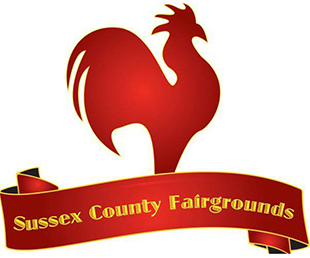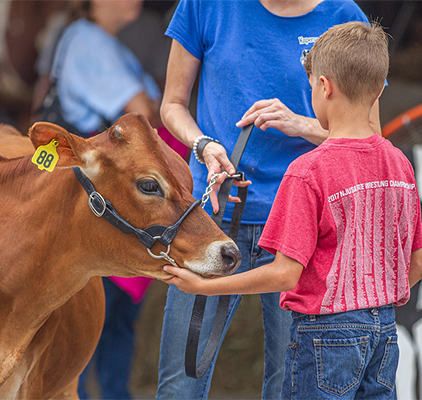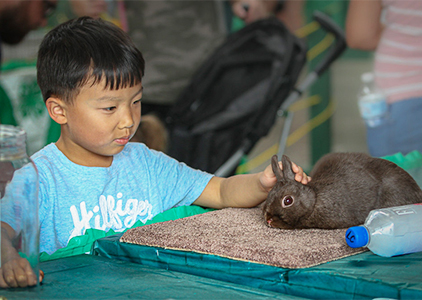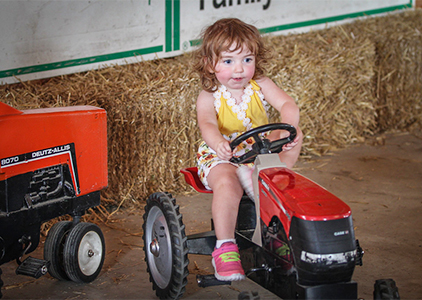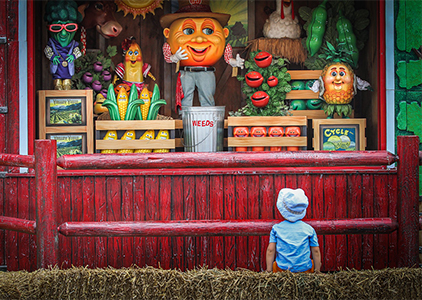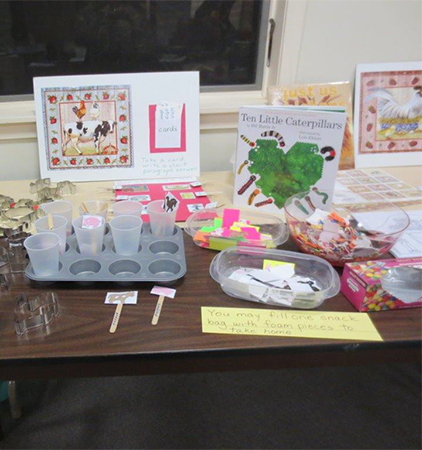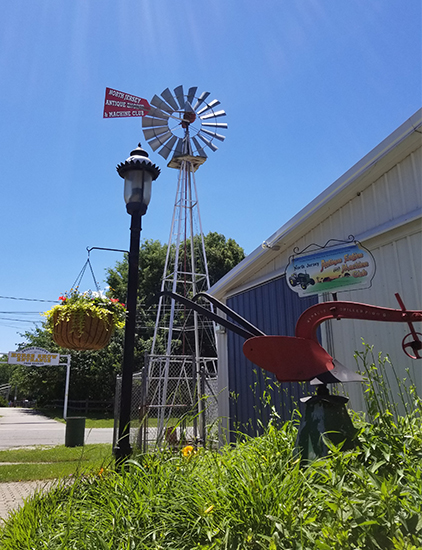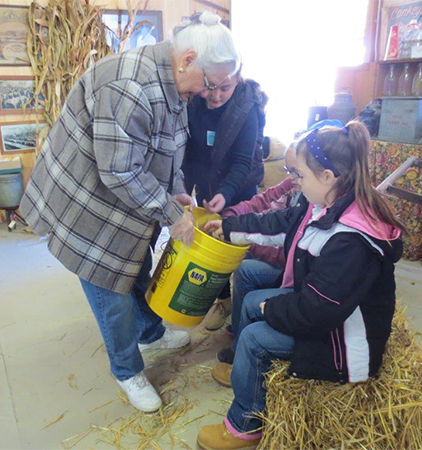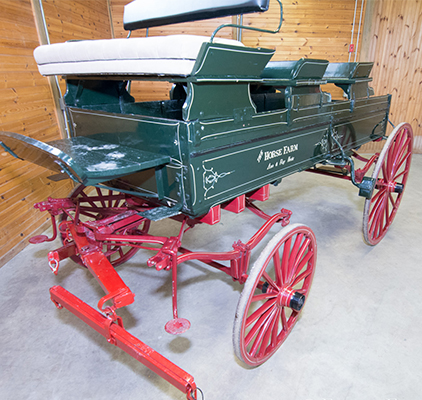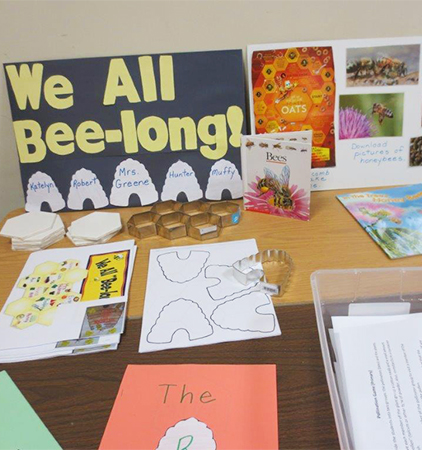AG Bag Catalog
AG Bags were developed as a way to infuse agriculture into your regular curriculum. They are a free service from the AG Learning Center. They were developed by former teachers with experience in pre-kindergarten to 5th grade.
To order an AG Bag, please contact Kathy Cafasso, Program Director, to see if the bag you wish is available [kcafasso@njstatefair.org]. Include your name, grade, school, district, and contact information as well as when you would like the Bag delivered. A form will be emailed to you with drop off and pick up dates and must be signed and faxed back to the Learning Center. We will deliver and pick up the Bags from your school office. You will be responsible for returning the materials in acceptable condition.
Bags include hard and softcover books [primarily non-fiction], sample materials and other concept support materials as needed. Feel free to use any or all of the books that fit your needs. Most of the books are available at amazon.com or ordered from your local bookstore. A notebook is included with various projects/lessons/activities that address science, social studies, language arts, art, etc. Feel free to make copies of any of the pages in the notebook, but please do not remove the paper from the plastic sleeves. [If you wish a copy of a color illustration that doesn't have a website listed, email us and we will send it to you.]
We have included a zip case of materials that you can make from some of our resources. You may make copies of the sample materials as well. If you have a way to use the materials in a new way, we would be happy to add your ideas to the Bag and will credit you. We continue to update the Bags with new books and materials. [All Bags contain the anchor books but may not contain all the supplement books listed. Let us know if you wish a particular supplement book included.] Also let us know if you are only interested in one or two specific books.
Each AG Bag may be borrowed for 2 weeks. If you are finished before the two weeks, an earlier pickup date can be arranged. Please be sure to complete the evaluation form at the front of the notebook as it helps us to keep the Bag fresh and relevant. If there is a sponsor postcard included, please jot a short message and mail it. Sponsors have made it possible to include the amount of books we use. If you know of any individual or business that might be interested in sponsoring a bag, please let us know.
Please be aware you will be responsible for the condition of all materials in the bag. Any damage will be billed to you, the teacher, personally.
The Learning Center thanks Branchville Rotary Club for the funding for the consumables in the AG Bags, and the individuals and companies that sponsored the books.
Non-fiction books are notated with N; fiction books are notated with F.
To find out more information about the programming at the Agricultural Learning Center visit www.agriculturallearningcenter.org.
To view a topic click on the topic name and down arrow.
APPLES – pre-kindergarten to 4th grade level
Sponsored by Tri-State Insurance Agency, Branchville Rotary Club, Sussex County Board of Agriculture.
Whether you are interested in the growing stages of apples, of the many different kinds of apples, or about apple products, this Bag has it all. The books contain many facts about apples with great illustrations/photographs. Lessons on sequencing, life cycles, use of resources, folktales, different kinds of a plant, or science experiments/riddles can use these books.
Consider borrowing our crockpot and apple corers/peelers from our Borrow Bag Program and making applesauce.
Anchor Books: The Apple Pie Tree [F] by Zoe Hall; The Seasons of Arnold's Apple Tree [F] by Gail Gibbons- stages in an apple tree's life
Supplemental Books: [Some of these books are included; let us know if you wish for specific books from the list below.]
- Apples [N] by Gail Gibbons – apple facts and diagrams
- Apples A to Z [F] by Margaret McNamara – fictional characters reveal apple facts for each letter of the alphabet
- The Story of Johnny Appleseed [F]by Aliki – simple text telling the legend
- Johnny Appleseed [F] by Reeve Lindbergh – (poet/author daughter of Anne Morrow Lindbergh & Charles Lindbergh) tells the story in rhyme, illustrations are folk art paintings with quilting motifs- for 2nd-3rd grades
- How Do Apples Grow? [N] by Betsy Maestro – from the 'Let's find out science series – large, clear illustrations and diagrams, good illustrations for younger students but has harder text
- Apples for Everyone [N] by Jill Esbaum – photographs illustrate an apples' growth, variety, uses and history
- Apple Farmer Annie [F] by Monica Wellington – Annie has her own orchard and makes many apple products, but she also sells at a city farmers' market
- The Apple Orchard Riddle [F] by Margaret McNamara & G. Brian Karas – Farm Bureau's Agriculture Book of the Year – Mr. Tiffin's class learns facts on a class trip to an orchard including the answer to a riddle
- Ten Apples Up on Top [F] by Dr. Seuss – counting activity in typical Dr. Seuss style
BEES – primary/elementary level
Sponsored by Sussex County Beekeepers.
Information about the social structure of bees, the making of honey and pollination is outlined in these books. For a study of animals, insects, plants, communities or the natural world – these books are great additions. This bag includes books and materials for pre-kindergarten to 5th grade.
Anchor Books: In the Trees, Honey Bees, by Lori Mortensen [N] – has large pages full of colorful illustrations. Simple rhyming text is at the top "Sisters fly through the sky. Nectar sweet, pollen treat." while factual text is minimal at the bottom of the page. This book was named Outstanding Science Trade Book by the Children's Book Council & National Science Teachers Association.
These Bees Count! [F] by Alison Formento – tells of a class who visits a farm that produces honey. The students don beekeeper gear and learn about bees.
Supplemental Books: [Some of these books are included; let us know if you wish for specific books from the list below.]
- The Honey Makers [N] by Gail Gibbons – contains facts about bees and large, colorful illustrations. They are large enough to be used with younger children without reading the text.
- The Magic School Bus Inside a Beehive [F] by Joanna Cole & Bruce Degen – typical Magic School Bus with Ms. Frizzle at the wheel- lots of charts and facts
- The Life & Times of the Honeybee [N] by Charles Micucci – is designed with two page 'chapters’ like Home Sweet Home and Egg to Bee. It could be read in bites to a class. This book was named Outstanding Science Trade Book by the Children's Book Council & National Science Teachers Association
- Are You a Bee? [N] by Judy Allen – describes your life as a bee. "Your brothers are drones. They don't do much." The book ends with the information that you are not a bee, but these are the things you can do
- The Case of the Vanishing Honeybees – a Scientific Mystery [N] by Sandra Markle – targets older students with the mystery of what is killing the honeybees. Lots of photographs, which can be used with younger students, illustrate the pages. There are 5 small 'chapters' that can be read over several days. The back of the book contains a glossary, website and information on global and local rescues
- The Bee Man [F] by Laurie Krebs – Farm Bureau Agriculture Book of the Year – The behavior of bees is told in rhyme by a child whose grandfather is a beekeeper
- Honeybees [N] by Joyce Milton – a Level 3 transitional reader from the Penguin Young Readers series, this book gives basic bee facts
BERRIES/BLUEBERRIES FOR SAL – primary/elementary level
A good pairing of fiction and non-fiction, or comparing stories centered around berries.
Anchor Book: The Berry Book [N] by Gail Gibbons- Berries grow on every continent but Antarctica in many ecosystems. Gibbons shows many types of berries, edible, inedible and poisonous. There are recipes in the back.
Supplementary Books: [Some of these books are included; let us know if you wish for specific books from the list below.]
- Blueberries for Sal [F] by Robert McCloskey- Little Sal and Little Bear get separated from their mothers while walking on Blueberry Hill. Caldecott Honor Book
- Jamberry [F] by Bruce Degen- Author Degen got his berries from the wild as a boy. It was the inspiration for this poem/story about a boy and a bear.
- Berries to Jelly [N] by Inez Snyder- From the Welcome Book series, this small book uses photos and minimal text to track berries being made into jelly.
- Flicka, Ricka, Dicka and the Strawberries [F] by Maj Lindman- A series created by Swedish author/artist Lindman, this book tells how the three lookalike girls go out berry picking and get lost, only to be rescued by a family with more heart than money. Originally published in 1946
- Berries, Nuts and Seeds [N] by Diane L. Burns- The Berries section of this book tells "What it looks like", "Where to find it", "What it eats" and "Interesting Facts." Includes unusual selections such as wintergreen, juniper, sumac, bunchberries and currants- directions are given for making berry watercolors.
- Blueberries Grow on a Bush [N] by Mari Schuh- Photos and minimal text illustrate different kinds of berries and how they grow- index included.
- Strawberry [N] by Jennifer Coldrey and George Bernard- Large photos illustrate the parts and life cycle of strawberry plants- index included.
CHRISTMAS TREE FARMS – primary/early elementary level
Sponsored by Stonerow Christmas Tree Farm.
Evergreen trees don't grow in a perfect shape. It takes lots of work to grow them. In this Bag, the books help to tell the sequence of growing trees, how to identify them and how to differentiate conifers and deciduous trees. This bag includes books and materials for preK-grade 4. Time lines, math calculation, cooperation, and categorizing go well with these books.
Anchor Books:
- Christmas Farm [F] by Mary Lyn Ray- tells of Wilma, who wants something different for her garden one year and decides to plan evergreens. With the help of her five-year-old neighbor they start with 62 dozen trees. Over the years some trees succumb to various things as the story carries through until the trees are old enough to sell. A nice introduction to tree farming-
- Christmas Tree Farm [F] by Ann Purmell- also tells the story of growing evergreens to sell. In this book Grandpa owns The Christmas Tree Hut. His granddaughter narrates the story.
- Night Tree [F]by Eve Bunting- tells of a family that returns every year to the woods to decorate the same evergreen with popcorn and fruit to feed the animals.
- Winter Trees [F] by Carole Gerber-A boy and his dog's walk through the woods helps to highlight the different kinds of trees- conifer and deciduous- by identifying their shapes, bark, needles and cones.
- Pine Trees [N] by Allan Fowler- a Rookie Read-About Science Book- this small book has pictures and minimum large text plus an index.
- The Littlest Evergreen [F] by Henry Cole- is a first-person account of the life of the evergreen tree from seedling to tree in a family's house.
COMMUNITIES – early elementary level
Sponsored by Harold & Lois Pellow, Sussex Kiwanis, Larry & Mary Ann.
A great accompanying resource for teaching communities, this Bag contains a variety of presentations of country and city. Use to show the shift from rural to urban, kinds of community resources, city agriculture and housing used worldwide.
Anchor Book: Town Mouse Country Mouse [F] by Jan Brett- retelling of fable comparing the bounty of the town to the safety of the country; Brett's incredible illustrations with borders of found objects and hidden messages expand the story.
Supplemental Books: [Some of these books are included; let us know if you wish for specific books from the list below.]
- The Little House [F] by Virginia Lee Burton- life history of a house located in the country which gradually becomes a city; evolution of a neighborhood- winner of the Caldecott Medal
- Alphabet City [N] by Steven Johnson- Clever photos find the letters of the alphabet all over an urban environment.
- What is a Community from A to Z? [N] by Bobbie Kalman-"C is for culture, D is for development, E is for environment." Photographs and illustrations accompany an alphabet of all the parts of a community.
- Country Road ABC [N] by Arthur Geisert-ABCs taken from an actual farming community with a running panorama on the bottom of the pages; glossary
- Town & Country [N] by Alice & Martin Provensen-All of the many things to see and do in the city, followed by the same in the country; good for recalling details
- Home [N] by Carson Ellis- shows real and imaginary homes around the world.
- City Green [F] by DyAnne DiSalvo-Ryan- City dwellers rescue a vacant lot with a garden.
- If You Lived Here- Houses of the World [N] by Giles Laroche- Simple paragraphs describing homes around the world [yurts, chalets, pueblos, etc.], with large illustrations, also includes additional details in smaller font
- Last Stop on Market Street [F] by Matt De La Pena- Winner of the 2016 Newbery Medal, A 2016 Caldecott Honor Book, A 2016 Coretta Scott King Illustrator Honor Book, A New York Times Book Review Notable Children's Book of 2015, A Wall Street Journal Best Children's Book of 2015- Every Sunday CJ and his grandma ride the bus to their stop at Market Street, a run-down neighborhood. On this day, CJ wonders aloud why they don't have a car, why he doesn't have the things other children have, why he lives in this neighborhood. His grandmother shows him the real beauty in the world in which he lives.
Gr. 3: LS4.C: Adaptation:
For any particular environment, some kinds of organisms survive well, some survive less well, and some cannot survive at all. (3-LS4-3)LS4.D: Biodiversity and Humans:
Populations live in a variety of habitats, and change in those habitats affects the organisms living there. (3-LS4-4)
CRANBERRIES – primary/elementary level
Sponsored by The Sussex County Farm & Horse Show Association.
For use in the fall at harvest time, or as a lead in to Thanksgiving, this Bag covers fiction and non-fiction stories about the production and use of cranberries. Lessons on sequence, timelines, NJ crops, qualities, steps in a process (recipes) and folktales are among those that can make use of these books.
Anchor book: Time for Cranberries [F] by Lisl H. Detlefsen - Based on the author's experience, this tells of a small family business and goes through all the steps to a cranberry harvest.
Supplemental Books:
[Some of these books are included; let us know if you wish for specific books from the list below.]
- Cranberry Thanksgiving [F] by Wende and Harry Devlin - A classic from 1971, part of a series about Maggie and her grandmother, this stresses the importance of sharing and making false assumptions. The recipe for a great cranberry bread is on the back.
- Cranberry Christmas [F] by Wende and Harry Devlin - Maggie, Grandmother and Mr. Whiskers return for a holiday story from 1976, including a recipe for cranberry cookies.
- Clarence, the Cranberry Who Couldn't Bounce [F] by Jim Coogan - Written by a retired high school history teacher from Cape Cod, this story is about Clarence, who is learning all about the harvesting procedure and trying hard to make the grade.
- Cranberries [N] by Inez Snyder - Part of the Welcome Books series by Scholastic, this small book has a contents and glossary page to model, with minimal text and great photos.
- Cranberries: Fruit of the Bogs [N] by Diane Burns - written for upper elementary with a lot of text, it nevertheless has excellent photos of the life cycle and uses of the cranberry.
- Cranberries from A to Z [N] by Ann Kurz - the content is not for primary, but will enrich vocabulary of older students.
- The Legend of the Cranberry- a Paleo-Indian Tale [F] by Ellin Greene -Based on a native American tale about the mastodon, this story has a great deal of text and is not appropriate for primary students.
ECOLOGY, ENERGY & INDIVIDUAL RESPONSIBILITY – primary/elementary level
Sponsored by Eastern Propane.
Each nonfiction book in this Bag addresses the efforts of an individual to change their piece of the world. These books illustrate JFK's words "One person can make a difference, and everyone should try." If you are discussing community projects, energy, ecology, recycling, women's history or third world conditions you will find these books valuable. You may request specific books.
LS4.D: Biodiversity and Humans: Populations live in a variety of habitats, and change in those habitats affects the organisms living there. (3-LS4-4)
- The Mangrove Tree- Planting Trees to Feed Families [N] by Susan L. Roth & Cindy Trumbore - How a scientist, Dr. Gordon Sato, develops a plan to use mangrove trees to change the whole economy of a poor African country; 'House that Jack Built' poetry on one page, prose on the opposing page, with beautiful mixed media illustrations. Sato was interned in Manzanar Camp during WWII and has chosen to call his work The Manzanar Project. Several pages at the end of the book give additional information & photos.
- Beatrice's Goat[N] by Page McBrier- Heifer International operates by the maxim "If you give a man a fish, you feed him for a day. If you teach a man to fish, you feed him for a lifetime." This is the true story of how the donation of a goat benefited a family and a community. The author and illustrator traveled to Uganda to meet with the family in order to make this story authentic.
- Mama Miti- Wangari Maathai and the Trees of Kenya [N] by Donna Jo Napoli -Wangari Maathai was the founder of the Green Belt Movement to combat deforestation of Kenya. This book with its beautiful illustrations of oil paint and printed fabrics uses simple text to show how Wangari encouraged the women of the villages to plant trees specific to their problems. Wangari was awarded the Nobel Peace Prize and was elected to the Kenyan parliament.
- Wangari's Trees of Peace- A True Story from Africa [N]-by Jeanette Winter- Simple text tells the story of Wangari, who returned from college in America, where she had received a scholarship, to find deforestation in her country. She organized the village women to plant trees, and founded the Green Belt Movement.
- The Tree Lady- The True Story of How One Tree-Loving Woman Changed a City Forever [N] by H. Joseph Hopkins- "Meet Kate Sessions, a young woman with a grand passion for trees. She has guts. She has Vigor. And she has a vision- a green, leafy vision that will one day transform a city." Kate's city is San Diego & Kate, who grew up in the 1860s, decided to bring trees to change San Diego from desert to the home of Balboa Park. An excellent selection for Women's History Month in March
- One Plastic Bag- Isatou Ceesay & the Recycling Women of The Gambia [N] by Miranda Paul - Plastic bags are cheap and easy to use, but when they are discarded, the piles of them become a health hazard to people and livestock in Gambia. Isatou Ceesay creates a way for women to recycle the bags, clean up the environment and raise money.
- 14 Cows for America[N] by Carmen Agra Deedy- Kimeli is studying medicine in the U.S., and returns home with the Maasai tribe in rural Kenya after 9/11. He tells the story of what he witnessed to his tribe and they wish to help "these poor people" by giving that which they hold sacred- cows. When the American ambassador arrives, he is surprised and moved to tears by the gift of the Maasai. "There is no nation so powerful it cannot be wounded, nor a people so small they cannot offer mighty comfort."
- The Boy Who Harnessed the Wind [N]- by William Kamkwamba & Bryan Mealer- Droughts in Malawi, Africa killed the maize crops & brought famine. William [born 1987] cannot afford to go to school and goes to the American sponsored library. He reads about windmills and wind power and creates his own windmill from what he finds in the junkyard. The windmills create electricity and pump water. William went on to Dartmouth College, and speaks at environmental conferences.
- Energy Island- How One Community Harnessed the Wind and Changed Their World [N] by Allan Drummond- The Danish island of Samso takes on the challenge of creating renewable energy for the entire island through wind power. The story tells the steps the communities took to come together and be totally self-sufficient. Bright illustrations and page ends with detailed information about renewable and nonrenewable energy make this a great book to share with children in several grade levels.
- Who Likes the Wind? [N] by Etta Kaner- Questions about wind related issues, answered by opening a flap on the opposite page- minimal text.
FARMS – primary level
Sponsored by Sussex County Agricultural Society, Partridge Ridge Farm, Jane Phillips & the Sussex County Board of Agriculture.
Farms come in many sizes and grow plants and animals. This bag gives you a taste of the many kinds of farms, farm animals and crops. Lessons on responsibility, natural resources, timelines, seasons, opposites, careers, food sources, adult/baby animals can use these books.
Anchor Books: Farm [N] by Scholastic- Each two-page spread contains facts about kinds of farms, animals and crops with lots of photos. It includes a contents page, glossary & index.
Farming [N] by Gail Gibbons- This is divided into seasons and covers the inside and outside chores that are done. At the end of the books it shows different kinds of farms. Gibbons's illustrations are simple yet detailed.
Supplemental Books: [Some of these books are included; let us know if you wish for specific books from the list below.]
- The Year at Maple Hill Farm [F] by Alice & Martin Provensen- This book has simple text at the top of the page and more detailed text in the middle and/or bottom. The illustrations of the animals are beautiful and in many sizes. It takes you through a year on the farm month by month.
- A Day in the Life of a Farmer [N] by Heather Adamson-A question & answer format provides information about the work of a farmer, with photos.
- Farm Animals [N] by DK Publishing- This has lots of photos of adult and baby animals with some body parts labeled.
- Living on Farms [N] by Allan Fowler- This is a short comprehensive book about farms- different kinds, work, crops, etc. with photos.
- Jobs on a Farm [N] by Nancy Dickmann- From the World of Farming series, this defines a farm and covers the care of plants & animals with photos.
- Senses on the Farm [N] by Shelley Rotner- From the World of Farming Series, this covers all the senses, using plant & animals in photos. Minimum text
- Seasons on a Farm [N] by Nancy Dickmann- From the World of Farming series, this has simple text which covers a year on a farm, with photos.
- Farm Machines [N] by Nancy Dickmann- From the World of Farming series, this covers different kinds of machines like tractors & plows, with photos.
- My Cows [N] by Heather Miller- This is a simple text with photos about a boy and the cows he is raising on his farm with photos.
- Farm Animals [N] by Nancy Dickmann- From the World of Farming series, this has simple text and large photos.
- A Farmer's Alphabet [N] by Mary Azarian- Block prints in black and white illustrate the alphabet. Azarian designed this for the Vermont State Board of Education and they were given to all schools in the state. Azarian resides in VT.
- This is a Farmer[F] by Nancy Tafuri - This is a 'House that Jack built' story with large text and illustrations. It goes all through the farm yard, and has a mouse that moves through the pages as well.
- Sun Above and Blooms Below- A Springtime of Opposites [F] by Felicia Sanzari Chernesky- A field trip to a farm with opposites on every page- "A rooster crowed atop the coop. At the bottom, chicken poop!" [Chernesky lives in Flemington, NJ & does author visits. She has books about agriculture that use color, shapes & numbers.]
- Farm Alphabet Book [N] by Jane Miller- In a letter- word- sentence format, this book uses photographs to illustrate things on a farm.
- The Milkmakers [N] by Gail Gibbons- This tells how a cow produces milk and how it gets to your store. It has detailed illustrations and a good deal of text that can be easily summarized. A Reading Rainbow selection
- Food from the Farm [N] by Nancy Dickmann- This defines farm and the plants and animals raised on farms. It shows food that comes from these plants and animals in photos. From the World of Farming series
- Plants on a Farm [N] by Nancy Dickmann- Plants of many kinds- including rice- are shown being grown and harvested. This has minimal text.
- On the Farm[F] by David Elliott- Each two-page spread has a simple poem about a farm animal with large woodcut illustrations. A Bank Street College Best Children's Book of the Year
- Farm Animals [N] by Wade Cooper- A Level 2 Scholastic Reader, this has 2 pages devoted to each animal with photos and a 'Do you know?' section for each.
- Mrs. Wishy-Washy's Farm [F] by Joy Cowley- Mrs. Wishy-Washy's animals run away to the city, but finds it worse than being scrubbed on the farm. Written in rhyme.
- Otis [F] by Loren Long- Otis the tractor is mocked for his friendship with a calf, and replaced by a shiny new tractor. But circumstances prove that friendship is important and new is not always best
GARDENS & PLANTS – primary/elementary level
Primary level-
Sponsored by The Springfest Garden Show Committee.
This bag covers planting flower and vegetable gardens and all about seeds. Lessons on sorting/categorizing by quality, attributes of seeds, comparing/contrasting, creating beauty in the natural world, imagination, poetry among others can be done with these books.
Anchor Book: Planting a Rainbow[F] by Lois Ehlert- A riot of color, Ehlert has flowers from seeds and bulbs growing. Each color has multiple flowers listed.
How a Seed Grows [N] by Helene J. Jordan- From the Let's Read and Find Out Science Series, this book has a lot of text for primary students but has a good classroom planting activity and good illustrations.
Supplemental Books: [Some of these books are included; let us know if you wish for specific books from the list below.]
- A Seed is Sleepy[N] by Dianna Hutts Aston & Sylvia Long- This book has a wonderfully poetic text with a simple statement followed by an explanatory paragraph. It's one of those rare books that can be used with many different age groups. The outstanding up-close illustrations show a wide variety of seeds.
- Seeds Grow! [N] by Angela Shelf Medearis- Minimal text makes this seed to flower story perfect for young children.
- Seeds! Seeds! Seeds! [N] by Nancy Elizabeth Wallace- a collection of seeds sent by Grandpa sets Buddy on a search for seeds for his collection. Bags of different seeds keep arriving. A good book to use with seed sorting, it shows that the size of the seed doesn't correspond to the size of the plant.
- Ten Seeds[N] by Ruth Brown- shows how despite planting a lot of seeds, sometimes you get fewer plants. Minimal text with backwards counting and up-close illustrations show seed predators.
- Seeds [N] by Ken Robbins- Photographs show a wide variety of seeds, where they are in fruits and plants, and how they travel.
- Miss Rumphius [F] by Barbara Cooney- This classic tells the story of Miss Alice Rumphius who goes out in the world to make it a more beautiful place. Great as an introduction before planting flowers or seed bombing [see notebook].
- Flower Garden [F] by Ruth Bunting- A little girl and her father go to the store to buy flowers for a window box. The urban setting may be new for children. It has a simple rhyming test and bold realistic illustrations. A Parenting Magazine Outstanding Children's Book of the Year
- One Bean [F] by Anne Rockwell- Realistic fiction about a bean seeds trip from germination to producing its own seeds. This is a great intro to examining the inside of a seed and planting them. American Booksellers Pick of the Lists
- Jack & the Beanstalk [F] by various authors - Use this fairy tale as a companion to any planting book such as One Bean.
- Cheers for a Dozen Ears- A Summer Crop of Counting [F] by Felicia Sanzari Chernesky- A visit to a farm stand has a brother and sister filling Mom's shopping list with farm produce. A New Jersey author [Flemington] who does school visits- we have her contact info
- A Gardener's Alphabet [N] by Mary Azarian- block prints illustrate this alphabet book.
- My Garden [F] by Kevin Henkes- "In my garden, the rabbits wouldn't eat the lettuce because the rabbits would be chocolate and I would eat them." All kinds of magical things will be in this little girl's garden.
- And then it's spring [F] by Julie Fogliano- With a small amount of text this recent book illustrates the long wait between planting and the arrival of seedlings - things stay brown for a very long time.
- In the Garden with Van Gogh [F] by Julie Merberg & Suzanne Bober - is a board book that uses many of Van Gogh's nature paintings.
Elementary level-
Sponsored by The Springfest Garden Show Committee.
This bag covers planting flower and vegetable gardens and all about seeds. Lessons on sorting/categorizing by quality, attributes of seeds, comparing/contrasting, creating beauty in the natural world, imagination, poetry among others can be done with these books.
Anchor Book: From Seed to Plant [N] by Gail Gibbons- This is a great intro to seeds, flowers and plants. It has a planting project in the back.
A Seed is Sleepy [N] by Dianna Hutts Aston & Sylvia Long- This book has a wonderfully poetic text with a simple statement followed by an explanatory paragraph. It's one of those rare books that can be used with many different age groups. The outstanding up-close illustrations show a wide variety of seeds.
Supplemental Books:
[Some of these books are included; let us know if you wish for specific books from the list below.]
- All About Seeds [N] by Melvin Berger [A Do It Yourself Science Book]- After each piece of information is a "Do it yourself" activity.
- The Reason for a Flower [N] by Ruth Heller - Heller's colorful detailed illustrations are the star of this book. There is just enough text to give facts without detracting from the flowers. A great beginning science book!
- Up in the Garden & Down in the Dirt [F] by Kate Messner- From planting to harvesting, there is activity above and below ground.
- The Gardener [F] by Sarah Stewart- Caldecott Honor Book Lydia Grace is sent on a train with her pockets full of seeds to live with her uncle the baker in the city. It's the 1930's and her family can't make ends meet. Lydia Grace sets out to use her seeds to make her uncle smile.
- Jack's Garden [F] by Henry Cole- Although the 'House that Jack Built' formula is suited for younger students, the detailed labelled illustrations of the animals, plants and tools in a garden make it great for older students- especially those who have gardens.
- The Flower Alphabet Book[N] by Jerry Pallotta & Leslie Evans - One flower for each letter of the alphabet, with a border on each page that has hidden information in it- artist's notes at the back reveal the facts.
- The Magic School Bus Plants Seeds- A Book About How Living Things Grow[F] by Joanna Cole and Bruce Degan- This book takes the students inside a flower to examine plant parts and pollen.
- How a Seed Grows [N] by Helene J. Jordan- From the Let's Read and Find Out Science Series, this book has a lot of text, a good classroom planting activity and good illustrations.
- Seeds [N] by Ken Robbins- Photographs show a wide variety of seeds, where they are in fruits and plants, and how they travel.
- One Bean [F] by Anne Rockwell- Realistic fiction about a bean seeds trip from germination to producing its own seeds. This is a great intro to examining the inside of a seed and planting them. American Booksellers Pick of the Lists
- Miss Rumphius [F] by Barbara Cooney- This classic tells the story of Miss Alice Rumphius who goes out in the world to make it a more beautiful place. Great as an introduction before planting flowers or seed bombing [see notebook].
GEORGE WASHINGTON CARVER – primary/elementary level
Sponsored by Safety Scaffolds.
This bag includes books and materials for preK-grade 5. Primary [activities including a mini-book, but none of these books are primary level specifically- selected pages can be used] & elementary [gr. 2-5]. This bag can be used for Black History Month or with lessons on creativity or use of resources among others.
Consider borrowing the food processor from the Borrow Box Program to make peanut butter if allergies are not an issue in your classroom.
Anchor Book: In the Garden with Dr. Carver [F] by Susan Grigsby- Although fiction, this beautifully illustrated book outlines the work Carver did through the voice of a young girl who experiences a visit by Carver to her school.
Supplemental Books: [Some of these books are included; let us know if you wish for specific books from the list below.]
- The Life and Times of the Peanut [N] by Charles Micucci - Two page mini-chapters with lots of pictures and diagrams, this book focuses on the peanut with information on Carver at the end.
- The Groundbreaking, Chance-Taking Life of George Washington Carver and Science & Invention in America [N] by Cheryl Harness- Another great biography by Harness, this chapter books includes a timeline and labeled illustrations. A good classroom read aloud.
- A Picture Book of George Washington Carver [N] by David A. Adler- From Adler's series of children's biographies, it's a simple outline of Carver's life.
- George Washington Carver- the Peanut Wizard [N] by Laura Driscoll- elementary biography
- A Weed is a Flower- The Life of George Washington Carver [N] by Aliki - More information than the Adler biography, but still simple
MAPLE TREES – primary/elementary level
Sponsored by Branchville Rotary.
This book could be used with a study of early America, rural life, where food comes from, farming or forests. Consider contacting a tree farmer in your community to speak to your class, or organize a syrup tasting. Sequencing, identifying steps in a process, life cycles, past/present, and technology through time are good concepts for these books.
Consider getting the griddle from our Borrow Box Program and making mini-pancakes.
Anchor Book: Sugarbush Spring [F] by Marsha Wilson Chall- has wonderfully realistic paintings telling the story of Rosie's Grandpa's sugaring at his farm. Although the book is set in modern times, the essential process hasn't changed for two hundred years.
Supplemental Books: [Some of these books are included; let us know if you wish for specific books from the list below.]
- A Tree for All Seasons [N] by Robin Bernard [N] A large format, photographic book by National Geographic Children's Books, this shows the life of a maple tree.
- Sugaring Time [N] by Kathryn Lasky is illustrated with black & white illustrations. This book has a lot of text, better for elementary, but the photos are useful for any age. Newbery Honor Book
- At Grandpa's Sugar Bush [F] by Margaret Carney - outlines the sugaring process through the eyes of a grandson helping his grandfather. The book has great paintings for illustrations and not a great deal of text.
- Sugar on Snow [F] by Nan Parson Rossiter- features a farm family- mother, father and two sons- working at sugaring. It has quite a bit of text.
- Sugaring [F] by Jessie Haas- is similar to Sugarbush Spring, but with less text. It has the Grandfather/Granddaughter dynamic, with a Vermont setting.
- Sugar Snow [F] by Laura Ingalls Wilder - is from the My First Little House Books series. It has large illustrations and minimum text where Pa explains about his day at Grandpa's making syrup.
- Sugar White Snow & Evergreens- A Winter Wonderland of Color [F] by Felicia Sanzari Chernesky- is the third farm book this New Jersey ["where the snowfalls are measured with a yardstick”] author has written. This one highlights colors a family sees on the way to a farm to see about syrup and have breakfast. [Chernesky lives in Flemington, NJ & does author visits. She has books about agriculture that use color, shapes & numbers.]
- Sap to Syrup [N] by Inez Snyder [Scholastic Welcome Book] from the How Things are Made series, this book has simple text and photographs
- Welcome to Our Sugarhouse [F] Pyramid Publishing- a coloring book that illustrates the steps of sugaring, with a fact page, a maze page, a draw your favorite maple product page- may be used to reproduce specific pages
PLANTS: VEGETABLES & FRUITS – primary/elementary level
Primary level-
This Bag introduces fruits and vegetables in all of their glory! The two Sayre books have outstanding closeup photographs with minimum text. A Fruit is a Suitcase for Seeds gives facts about the growth of fruits. The books show parts of plants.
Consider borrowing a crockpot from our Borrow Box Program and making stone soup.
Anchor Books: Rah, Rah, Radishes! A Vegetable Chant [N] -by April Pulley Sayre- photographs of vegetables at farmers' markets presented as a chant ["oh, boy, bok choy!"], introduces students to many kinds of vegetables in lots of color
Supplemental Books: [Some of these books are included; let us know if you wish for specific books from the list below.]
- Go, Go, Grapes! A Fruit Chant [N] by April Pulley Sayre - similar to the anchor book, highlighting fruit
- Eating the Alphabet: Fruits and Vegetables from A to Z [N] by Lois Ehlert - multiple fruits and vegetables for each letter of the alphabet in large colorful illustrations
- A Fruit is a Suitcase for Seeds [N]- by Jean Richards - where fruit seeds are located, how they travel, how they grow
- Stone Soup [F] - by various authors-The classic about a village getting fooled into providing all the vegetables for a magical soup made only of stones and water.
- Vegetable Garden -by Douglas Florian [N] - "Big and round, melon mound." Minimal text outlines the work to make a vegetable garden.
- Growing Vegetable Soup [F]- by Lois Ehlert- typical Ehlert illustrations of ingredients
Elementary level
Sponsored by Eastern Propane.
This book highlights fruits and vegetables. It shows a wide variety of both in great color photos in the Sayer books. Gibbons's book shows parts of a vegetable. The last two books are good to use with writing assignments.
Anchor Book: Rah, Rah, Radishes! A Vegetable Chant [N] by April Pulley Sayre- photographs of vegetables at farmers' markets presented as a chant ["oh, boy, bok choy!"], introduces students to many kinds of vegetables in lots of color
Supplemental Books: [these are some of the books included; let us know if you wish for specific books from the list below.]
- Go, Go, Grapes! A Fruit Chant [N] by April Pulley Sayre- similar to the anchor book, highlighting fruit
- The Vegetables We Eat [N] by Gail Gibbons- leaf, bulb, flower bud, root, tuber, stem, fruit, seed- different parts of vegetables are eaten; tips on growing vegetables
- I Will Never NOT EVER Eat a Tomato! [F]- by Lauren Child- in order to get his sister Lola to eat vegetables, Charlie invents names for them like orange twiglets from Jupiter (carrots); good springboard for creative thinking/writing
- June 29, 1999 [F] by David Wiesner- Holly Evans of Ho-Ho-Kus, NJ has a science experiment that seems to have gone horribly wrong when giant vegetables fall from space
Gr. 3:
LS4.A: Evidence of Common Ancestry and Diversity: Some kinds of plants and animals that once lived on Earth are no longer found anywhere. (3-LS4-1) Heirloom vegetablesPOLLINATORS/BUTTERFLIES – primary/elementary level
Pollinators have a very important part in the production of food. Although most children may think of butterflies and hummingbirds primarily as pollinators, they come in several forms, including people. Lessons on lifecycles, classifying, cause and effect and the needs of specific lifeforms among others may be used with these books.
Anchor Book: Caterpillars, Bugs and Butterflies [N] by Mel Boring- A "Take Along Guide", this book is great for a study of different kinds of insects. Each page has a 'What it eats', 'What it looks like' and 'Where to find it' section as well as activities.
Supplemental Books:[these are some of the books included; let us know if you wish for specific books from the list below.]
- Monarch Butterfly [N] by Gail Gibbons-another hit by the master of children's non-fiction, this tells the story of the life cycle of the monarch with its journey south. At the end are supplementary facts.
- Monarch and Milkweed [N] by Helen Frost- Beautiful illustrations by Leonid Gore join imaginative descriptions by author Frost, whose backyard in Indiana is a certified Monarch Waystation. Gore emigrated from Russia in 1991 from Russia and lives in Oakland, NJ, "where monarchs are occasionally sighted."
- Butterflies [N] by Marfe Ferguson Delano- Part of the 'Explore my world' series by National Geographic Kids, this book has large fonts and photographs making it good for primary students.
- Gotta Go! Gotta Go! [F] "The life cycle of a monarch butterfly is told in simple language and illustrations as the story of a creepy-crawly bug who knows that 'I gotta go! I gotta go to Mexico!' Transformed into a butterfly, she continues to pursue her destiny." The New York Times Review Book Review
- Follow the Wind Wherever It Blows [F] by Paddy Lynn- Butterflies stop by fields asking "Can you tell us where the milkweed grows?" only to get the answer "Follow the wind wherever it goes." This book grew out of a children's theater piece, and would lend itself to a class presentation.
- A Butterfly is Patient [N] by Dianna Hutts Aston, Sylvia Long- from the pair that brought us A Seed is Sleepy and An Egg is Quiet, this book has a single line of text "A butterfly is creative." with a small paragraph of explanation. Butterflies throughout are labelled, and includes an entry "A butterfly is not a moth!" explaining the differences.
- Caterpillars Love to Eat [N] by Traci Dibble- from the Training Wheels Reading series, this beginning book has a controlled vocabulary and big bright photos.
- Bats [N] by Gail Gibbons- goes through the many kinds of bats found around the world and includes their work as pollinators.
- What is Pollination? [N] by Bobbie Kalman- this book covers a wide variety of pollinators, while explaining the process of pollination. It has a small amount of type with colorful photos. It contains a contents, glossary and index.
- Insect Pollinators [N] by Jennifer Boothroyd- with a table of contents, glossary and index, this book has one or two lines of type with closeup photos showing different types of pollinators and touches on protecting them.
NSTA activity [http://ngss.nsta.org/Resource.aspx?ResourceID=137]
PUMPKINS – pre-kindergarten to 4th grade level
Sponsored by Northwest Jersey Reading Council, the 4-H Foundation and Sussex County Board of Agriculture.
This Bag's books highlight the life cycle of the pumpkin plant. In photos and illustrations, the books show the entire cycle, including post Halloween. Most of these books are not Halloween-centric. Science lessons on comparing, buoyancy, counting, life cycles, sequencing, time lines of crops can be done with these books.
Anchor Books: Pumpkin Circle- The Story of a Garden [N] by George Levensen- large photos track the life cycle of a pumpkin; It’s Pumpkin Time [F]by Zoe Hall- life cycle of a pumpkin told by children getting ready to make a jack o' lantern
Supplemental Books: [Some of these books are included; let us know if you wish for specific books from the list below.]
- The Pumpkin Book [N] by Gail Gibbons- another gem by Gibbons with detailed illustrations covering life cycle, history, directions on carving a pumpkin-could be used as the anchor book for grades 1-3
- How Many Seeds in a Pumpkin [F] by Margaret McNamara- class tries to answer the question and discovers the largest pumpkin doesn't have the most seeds
- Ready for Pumpkins [F] by Kate Duke- Herky, the classroom guinea pig decides to grow his own pumpkins- shows the life cycle in the story.
- Patient for Pumpkins [F] by Linda L. Knoll- A boy goes to the farmers' market starting in May looking for a pumpkin. Each month the local produce available is shown as well as the stage a pumpkin plant is in at that month.
- Pumpkins [N] by Jacqueline Farmer- historic background to the growth and eating of pumpkins, background of their use at Halloween, recipes
- Seed, Sprout, Pumpkin, Pie [N] by Jill Esbaum- Photos show the steps from seeds to finished pie.
- Pumpkin Pumpkin [F] by Jeanne Titherington- classic primary book with beautiful illustrations
SHEEP & FIBER – primary/elementary level
Whether you are covering natural resources, colonial crafts, kinds of farms, the production of clothing and or/fibers, this Bag addresses the basic steps from sheep to garment. These books can be used for lessons on sequencing, attributes, making art with fiber, colonial days, sharing and generosity among others.
Anchor Book: Feeding the Sheep [F] by Leda Schubert is a journey from sheep to sweater by a mother being constantly questioned by her daughter. The answer to "What are you doing?" is a couplet- 'Drying the wool, her mother said. Windy day, wool ballet.'
Supplementary Books: [Some of these books are included; let us know if you wish for specific books from the list below.]
- Weaving the Rainbow by George Ella Lyon [F] has a main character who is an artist, not making sweaters or mittens, but a wall hanging. Breathtaking illustrations show the steps from newborn lamb, through shearing, dyeing, weaving to the final product.
- Extra Yarn by Mac Barnett [F] Annabelle lives in a black and white town until she finds a box of rainbow yarn. She knits for everyone in town, including animals & buildings. When the archduke steals Annabelle's box, he discovers a mystery. [Included is information on yarn bombing.]
- "Charlie Needs a Cloak [F] by Tomie dePaola- Everyone tells Charlie the Shepherd that he needs a new cloak. This book shows all the steps Charlie goes through from shearing to sewing to make a new cloak for himself. Minimal text and great dePaola illustrations!
- A New Coat for Anna [F] by Harriet Ziefert- Anna needs a new coat but the war has made it difficult to get many things. Anna's mother is resourceful and trades things for the necessary materials and skills. Anna is required to be patient during the long time it takes for the coat to be made. Steps from shearing to sewing are shown. More text in the story than "Charlie Needs a Cloak."
SUNFLOWERS – primary level
Information about the life cycles of sunflowers, as well as some imaginative storytelling can be used in science or art lessons.
- Sunflower House [F] by Eve Bunting Building a circular 'sunflower house', the narrator enjoys a place to play and imagine with friends. When fall comes, he discovers that it's not the end of the house.
- Sunflower [N] Science Life Cycles Series, by David M. Schwartz - Close up photos illustrate the life cycle of a sunflower, including pollination by bees.
- This is the Sunflower [N] This is a poem illustrating the seasons of a sunflower. Donald Crews did the illustrations.
- Van Gogh and the Sunflowers [F] by Laurence Anholt - Fictional telling of a young boy who appreciates the artist’s work, includes reproductions of his work.
- A Field of Sunflowers [N] by Neil Johnson From using a disc plow to turn over the soil prior to planting, to leaving the sunflowers in the field for the birds, this book covers the life cycle of a sunflower field.
WATER – primary/elementary level
Primary level sponsored by Newton Rotary Club.
The importance of water in today's world cannot be underestimated. These books highlight the water cycle, the uses of water in your home and around the world, conservation, the states of water, and worldwide water programs. They can be used in units on plants & weather.
Anchor Book: All the Water in the World [N] by George Ella Lyon - Beautiful artwork and text in different fonts and sizes stress that all the water in the world is all the water there is. [NSTA activity: http://ngss.nsta.org/Resource.aspx?ResourceID=528]
Supplemental Books: [Some of these books are included; let us know if you wish for specific books from the list below.]
- A Cool Drink of Water [N] by Barbara Kerley-- Stunning photos from National Geographic show people from around the world & how they get water. Has minimal text & an annotated page for each photo
- Follow the Water from Brook to Ocean [N] by Arthur Dorros - Follows the journey of water to the ocean, touching on dams, reservoirs, erosion, waterfalls and meanders- upper primary
- Down Comes the Rain [N] by Franklyn M. Branley - Covers the three states of water and the water cycle-upper primary
- Splish! Splash! A Book About Rain [N] by Josepha Sherman - Simple illustrations show the water cycle and facts about rain. Included is a table of contents, glossary, simple index and experiment. Upper primary
- Mushroom in the Rain [F] by Mirra Ginsberg -- Animals take shelter under a mushroom that is able to shelter each in turn because the rain is making it grow.
- Bringing the Rain to Kapiti Plain [F] by Verna Aardema -- A 'house that Jack built' story introduces a Kenyan herdsman looking for rain for his herd of cows.
- I Am Water [N] by Jean Marzollo- simple easy to read facts
Elementary level sponsored by Newton Rotary Club.
The importance of water in today's world cannot be underestimated. These books highlight the water cycle, the uses of water in your home and around the world, conservation, the states of water, and worldwide water programs. They can be used in units on plants and weather.
Anchor Books: All the Water in the World [N] by George Ella Lyon - Beautiful artwork and text in different fonts and sizes stress that all the water in the world is all the water there is.
One Well-The Story of Water on Earth [N] by Rochelle Strauss-imagine that all of Earth's water came from one well; pairs of pages illustrate access to the well, animal & people using the well, demands on and pollution at the well, etc.
Supplemental Books: [Some of these books are included; let us know if you wish for specific books from the list below.]
- A Cool Drink of Water [N] by Barbara Kerley-- Stunning photos from National Geographic show people from around the world & how they get water. Has minimal text & an annotated page for each photo
- Water Dance [N] by Thomas Locker-beautiful paintings by Locker illustrate various bodies of water- cloud, waterfall, sea, storm, etc.; simple but poetic text
- Water, Water Everywhere [N] by Mark J. Rauzon & Cynthia Overbeck Bix-a Sierra Club/Reading Rainbow Book; introduces the forms & properties of water and the role it plays in the life of Earth; photographs
- A Drop of Water - A Book of Science and Wonder [N] by Walter Wick - Easily divided into two-page bites, with incredible photographs of water droplets, adhesion, condensation, 3 forms of water, etc.
